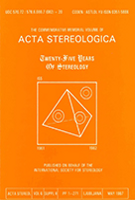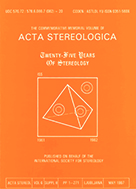- Accueil
- Volume 18 (1999)
- Number 2 - July 1999
- The use of stereological methods in neuroscience: what are we learning?
Visualisation(s): 573 (1 ULiège)
Téléchargement(s): 99 (0 ULiège)
The use of stereological methods in neuroscience: what are we learning?

Abstract
Efficient, unbiased stereological methods for quantitating macroscopic and microscopic structures in the central nervous system have been developed since 1984, and are superior" to the conventional assumption based methods previously used. The stereological method, the disector, a counting method, makes it possible to count particles e.g. cells and synapses, without bias, i.e. the selection of particles is not influenced by their size or shape. When the disector is used within a delineated region of the nervous system, whose volume is determined, the total number of particles is estimated. Even though over ten years has passed since the original description of the disector method, the disector is still the most important stereological method used in the field of neuroscience and when combined with specific labeling methods, such as immunohistochemical labeling or in situ hybridization, is a most powerful tool for quantitating structural and functional relationships. The application of stereological methods to non-invasive methods of imaging such as magnetic resonance imaging and computerized tomography, enables direct, quantitative study of the living human brain.
Pour citer cet article
A propos de : Ruth M.A. Napper
Department of Anatomy and Structural Biology, School of Medical Sciences, University of Otago, Dunedin, New Zealand






